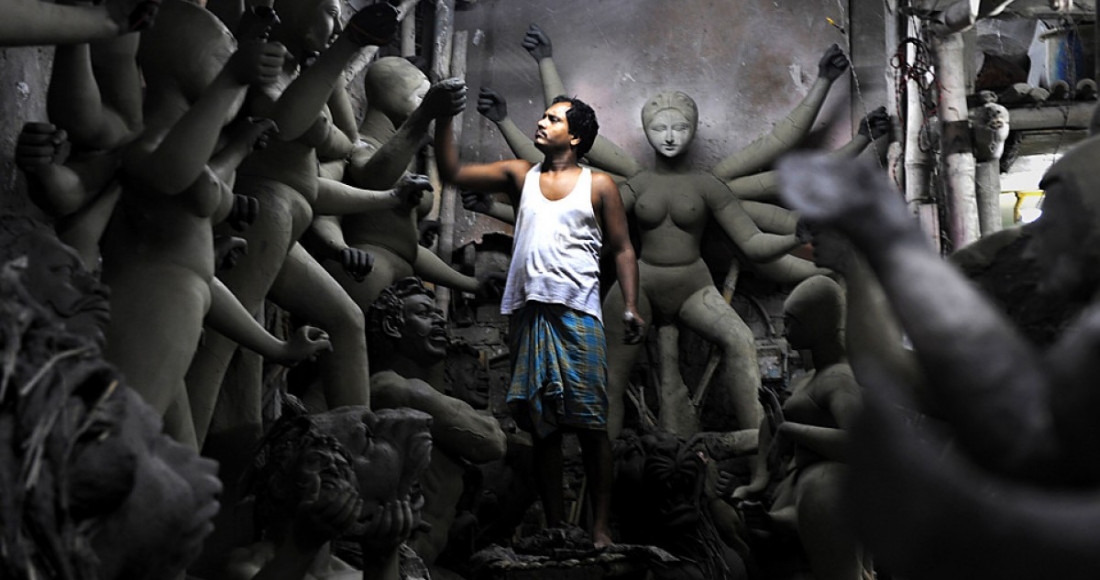Paintings of West Bengal
Patachitra Painting
One of the most magnificent cultural heritages of West Bengal is the Patachitra painting. Naya village of Paschim Medinipur area shelters approximately 250 Patuas or chitrakars, who specialize in the art of Patachitra. Innovative aspects such as Durga Pat, Chalchitra, Kalighat Patachitra, Medinipur Patachitra, and so on are peculiar to West Bengal.
Different regions of Bengal expertise in the creation of different colours and designs of Patachitra painting. For instance, Patachitra art of Purulia specializes in the shade of burnt sienna covered with white and yellow patches. The scrolls of the pots of Bankura, Birbhum, and Burdwan are especially known for their bright red background, whereas the scrolls of Hooghly prefer a dark brown shade.
Chalchitra
A part of Bengal Patachitra represents the Chalchitra art, which is also known as the Debi Chal or Durga Chala. The Chalchitra art generally adorns the background of the Durga idol.
The Patua artists also call it ‘Pata Lekha’, which means the writing of Patachitra. The origin of this art form is found to be 300–400 years ago when old idols of Nabadwip Shakta Rash used Chalchitra as a part of the Durga idol. It continues to be one of the most popular paintings even today.
Durga Sara/ Durga Pot Painting
Another painting related to Patachitra is the Durga pot or Durga Sara. The artists paint the picture of the deity of Goddess Durga in the middle of the Sara. Pictures of Shiva, Nangi-Vringi, Brahma, Vishnu, Ram, Sita are also painted in a semi-circular pattern. The paintings are detailed and vibrant.
These Saras or pots are also worshiped in the Hatsarandi Sutradhar society of Birbhum district and Katwa region during the festival of Durga puja. Krishnanagar Rajrajeshwari Durga is unique and popular in West Bengal in this respect.
The Idol Makers of Kolkata
Bengal is notable for one of the most majestic festivals of the country- the Durga Puja. It is fascinating to note that even the largest of Durga idols are created in the eight-by-eight art studios of Kumartuli in Kolkata (formerly known as Calcutta), the capital city of West Bengal.
Kumartuli, the potters’ paradise, gives birth to magnificently artistic Durga idols. Wooden walls and tin roofs of the studios shelter the deities and form a traditional home for the artists for centuries. The smell of wet Ganga clay and paints is associated with every Bengalee’s emotions.
The word “Kumartuli” is derived from the Bengalee words “Kumor” meaning potter and “Tuli” is a colloquial term for a small space. Hence, the place has been a home to numerous potters and model-makers. It is often said that these clay model-makers are the descendants of Maharaja Krishna Chandra of Krishnanagar, who is believed to have popularized the festival of Durga Puja.
The artisans get their proficiently creative hands and spirits ready on the first day of Bengali New Year, in April. The day marks the beginning of shaping and fixing the clay, preparing the deities for installation in various pandals throughout Bengal. Some eminent craftsmen of this place often receive orders from foreign countries, where they travel to create the iconic heritage idol of Goddess Durga.
Kumartuli stands out as an integral part of the state. Thousands of tourists and photographers crowd the place, especially a few days before the great festival starts. From eminent male artisans, such as Gopeshwar Pal and Jatin Pal; to women artists like China Pal and Namita Pal; and differently-abled craftsmen, like Ashok Pal, the place is diverse in its way.
Local Food of West Bengal
Bengal offers a diverse range of authentic dishes. Here, the cuisine is remarkable for a variety of flavours and a blend of spices. The state is already renowned for its spread of fish items, ranging from Daab Chingri (Tiger prawn), Bhetki paturi, to Shorshe Ilish (Hilsha fish). However, the delicacies transcend beyond it.
Dishes such as luchi (puri), alurdom, shukto, chholar daal, and kosha mangsho; and savouries such as nimki, jhal muri, and phuchka, the mouth-watering aura of which can readily make one drool. Rice and pulses form the staple food. Desserts and confectionary items, especially roshogolla and shondesh always take away the spotlight.
Picture Source: Pragyata



